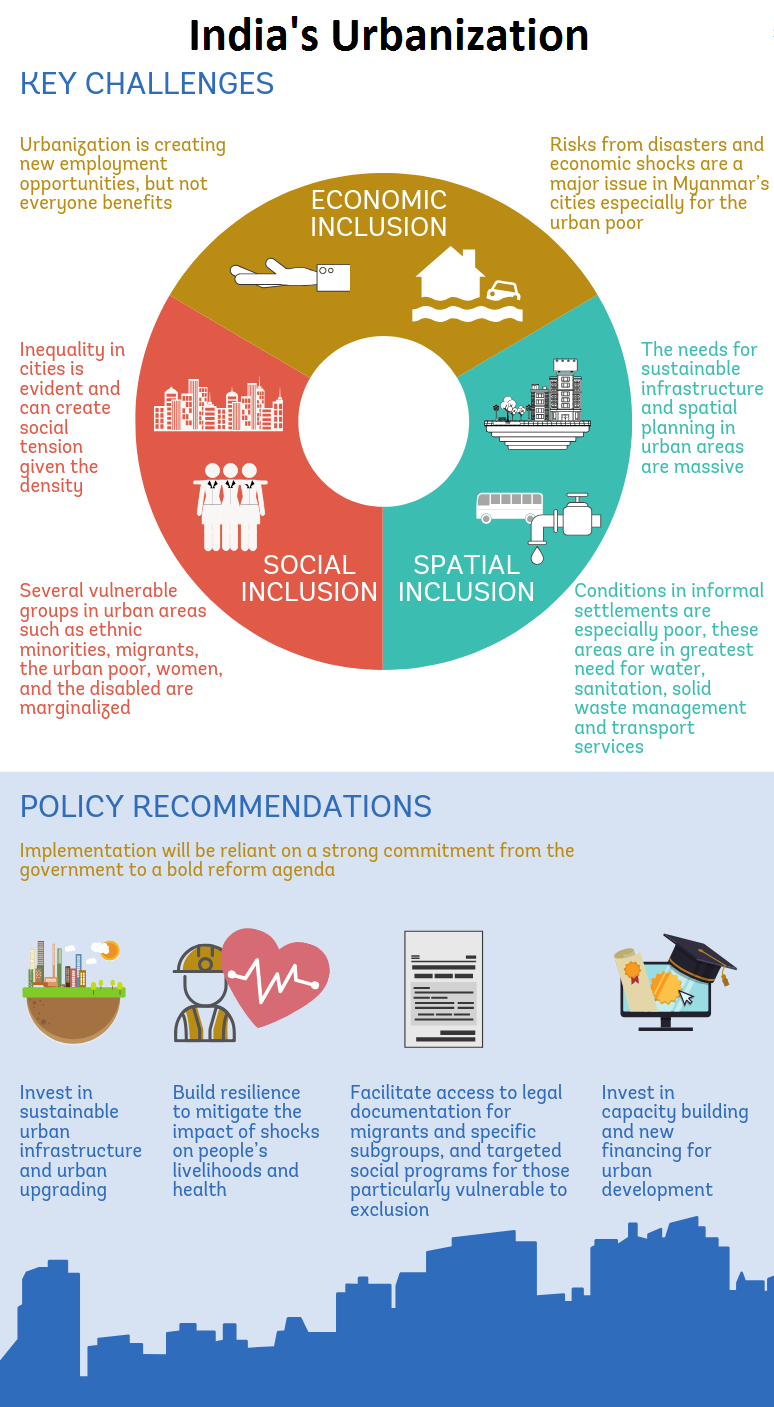Social Justice
Need For Urban Social Safety
- 12 Aug 2021
- 7 min read
This article is based on Comment An urban jobs safety net which was published in The Hindu on 11/08/2021. It talks about the challenges faced by the Indian Urban during the Covid-19 pandemic and the way forward.
During the pandemic, governments all over the world faced the difficult choice of saving lives versus protecting livelihoods. According to the World Economic Outlook report of April, 2021 of the International Monetary Fund (IMF), almost all countries, except China, experienced economic contraction last year. The global GDP shrunk by 3.3%.
India’s GDP fell by 8%. As per the Centre for Monitoring Indian Economy’s estimates, the unemployment rate in India peaked at 23.5% in April 2020 before falling to 6.9% in February 2021.
In the wake of economic deceleration, the challenge is to minimise livelihood losses. Traditionally, governments have addressed this issue from a sectoral viewpoint given the contemporary realities, the need is to approach this from a rural-urban perspective.
Social Security Issues Faced By Urban India
- Spread of Infection: In the Covid-19 outbreak in India, big cities such as– Delhi, Mumbai, Bengaluru and Chennai – were the main urban epicentres of the disease.
- Rural-Urban Livelihood Security Divide: Though the Indian government operates the National Urban Livelihoods Mission (NULM), which is focused on self-employment through skill up-gradation and credit linkages through banks, the scheme does not have guaranteed wage employment provisions akin to what MGNREGA provides.
- During the lockdown last year, the migrant labourers moved in large numbers from the urban to rural areas, which is symptomatic of the rural-urban livelihood security divide.
- This migration tragedy and the economic slowdown have highlighted the need for a similar livelihood safety net in urban India.
- Economic Effect: The economic crisis in urban areas is deepening as people who lost their jobs are yet to find replacements and little has been accomplished after the lockdown for the revival of livelihoods in the informal sector in the Indian urban area.
- Public Distribution System & Social Sector Scheme Coverage: A larger proportion of households in urban areas did not have access to ration cards.
- The social security schemes also had relatively better coverage among the rural poor as rural areas had better access to PDS rations.
- Nutrition and Hunger: A decline in nutritional quality and quantity was more among the urban residents, as was the need to borrow money for buying food.
The Need to Focus on Urban Areas
- Major Contributor to Economy: Urban areas are an integral part of the development process of the country. As in most countries, India's urban areas make a major contribution to the country's economy.
- Indian cities contribute to about two-third of the economic output, host a growing share of the population and are the main recipients of FDI and the originators of innovation and technology.
- Magnet For Businesses: The cities are a collective magnet for a great diversity of economic activities.
- The cities attract business and people, as a result of scale and agglomeration advantages (supply of educational facilities, presence of suppliers, etc).
- Hotbed of Social Capital: The cities are a hotbed of social capital or as a ‘melting pot’ of culturally or socially diversified groups.
- Cities are Power Centres: The city is an ever-expanding power-block, which reinforces its position to the detriment of towns and villages in its hinterland.
Way Forward
- Provision of Social Security: There is a need to provide livelihood safety access to urban areas.
- The livelihood safety net must have comprehensive coverage. Such a net, provided by the Mahatma Gandhi National Rural Employment Guarantee Scheme (MGNREGS), exists only in rural areas
- Promote Cooperation: An urban livelihood scheme can be launched within the existing fiscal space.
- If not, the Union and States can provide resources together and empower the urban local bodies.
- State Interventions:
- Himachal Pradesh has launched the Mukhya Mantri Shahri Ajeevika Guarantee Yojana (MMSAGY) with the objective of enhancing livelihood security in urban areas by providing 120 days of guaranteed wage employment to every household at minimum wages in FY 2020-21.
- MInimum Wages For Urban Workers: Setting a separate minimum wage for rural and urban areas does not cause migration to urban areas since the higher cost of living in urban areas has an offsetting effect.
- Focus on Service Delivery: The focus must shift from asset creation to service delivery. Restricting it to asset creation or wage-material ratios may be suboptimal in urban settings.
- The focus should be on enhancing the quality of municipal services.
Conclusion
India’s future urban strategy should improve urban governance, livelihood security of the urban poor, delivery of public services, inter-government transfers and capacity building.
|
Drishti Mains Question ‘Urban areas are growth engines of the country.’ In the light of the statement discuss the need for livelihood security to the people in the urban areas. |







